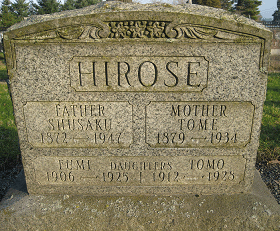Hirose Family
Shiusaku and Tome Hirose were among the earliest Issei generation Japanese to settle in the White River Valley. Shiusaku found work as a farm laborer. He and Tome were married about 1900 and began a family. All of their children were born in Washington, but that fact didn't keep a census-taker (who visited the family in 1910) from listing even the children's nativity as "Japan/Japanese"—just another example of the local white community refusing to acknowledge the American-born Nisei generation as being, in the opinion of their white neighbors, fully American.

Although several daughters and one son were eventually born to the couple, at least three Hirose children passed away before reaching adulthood. This, unfortunately, was not an uncommon fate for children in the early years of the 20th Century.
Despite their personal tragedies, the Hiroses were civic-minded people and leaders in the community. Education was clearly a high priority for the family. The surviving Hirose children all excelled in school and went on to earn college degrees. Daughter Ruby was the first of the White River Valley Nisei generation to graduate from Auburn High School. According to Stan Flewelling, in his book Shirakawa, "Hirose subsequently became the first Nisei to graduate from a university, earning her Bachelor's (1926) and Master's (1928) degrees in pharmacology from the University of Washington. She moved to the University of Cincinnati (Ohio), completed her doctorate in 1932, and was hired by the research division of the William S. Merrell Company, a pharmacological firm based in Cincinnati. Within a few years, Dr. Hirose was widely recognized in medical circles for developing vaccines against infantile paralysis and other diseases."
Ruby's younger brother Kimeo also achieved great success in his educational career. While attending Auburn High School in the mid-1920's, he made athletic history on the football field. He was a member of the 1925 County and State Championship football team, the only Auburn High School football team to ever achieve these titles. Later, he was named captain of the football team, was elected class treasurer, and triple-lettered in sports.
Father Shiusaku Hirose was instrumental in obtaining new facilities for the local Japanese Language School in 1929. The School's move out of its former quarters at the Buddhist Church allowed a new Japanese Language kindergarten to open there. In addition to being a prominent farmer, Shiusaku served as the Japanese PTA president and the Thomas Japanese Association president.
Unfortunately, the family's successes made little difference once President Franklin Roosevelt signed Executive Order 9066 (paving the way for the internment of people of Japanese ancestry) in early 1942. Author Stan Flewelling records the senior Hirose's story briefly in Shirakawa: "Shiusaku Hirose's was probably the saddest of all the White River cases... Hirose moved to Los Angeles in 1936 [he had been widowed in 1934], where he was working as a hotel janitor when the war broke out. He requested a permit to join his daughter, Mary, in Seattle before the evacuation process began. A week after his arrival, the Navy Shore Patrol found him wandering in a restricted area near the Seattle docks, arrested him, and turned him over to the INS. Judged harmless by the hearing board, he was paroled."
This parol did not mean escaping internment—he was then sent to join his daughter Mary's family at Minidoka Internment Camp in southeast Idaho. Son Kimeo was interned at Colorado River in Arizona. Neither Mary nor Kimeo had ever set foot on Japanese soil.